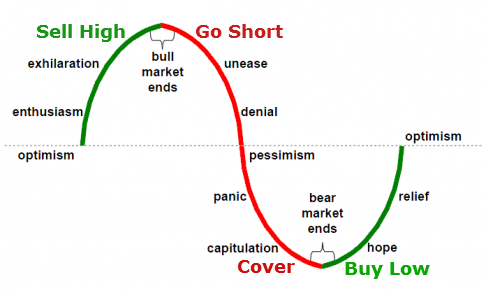
Continuation from yesterday……(The Composition Of 2000 -2017 Bear Market)
Investment Strategy #2: What Most People Did (The Reality….Worst Possible Outcome).
Think about the following for a second. While “Buying & Holding Forever” is a nice catch phrase, very few investors out there can do so consistently. For instance, how many people do you know that were able not only to hold on to most of their stock positions during the bear legs of 2002 and 2008, but to add to their positions during the time. Chances are, not many.
For the purposes of this discussion, let’s assume that ….
- You were fortunate enough to originate your position in November of 1994. Right before the final 600% run up took place.
- Subsequently, you sold out half way through all of the bear legs and bought back in half way thought all of the bull market legs.
… which should be lot better than what most people were able to accomplish during this difficult time.
Given the circumstances above, your total ROI should have been around 425% by September of 2014 and approximately 320% by the time the bear market of 2014-2017 completes itself. Yielding a net annualized rate of return of 8.5% and 6.5% respectively. Not bad, but once again, buying and holding a 30-Year US Treasury in 1994 would have outperformed this gut wrenching speculation in Nasdaq by a fairly good margin.
Investment Strategy #3: Buy Low, Sell High, Go Short and Cover
As was suggested earlier, based on the cyclical composition within the stock market you should have been aware that the last phase of the 1982-1999/2000 bull market was about to start. In addition, you should have been aware that the upcoming cycle is likely to develop as a powerful “blow-off top” 5-Year cycle. Leading you to initiate a long position in November of 1994.
Trade #1: Go long in November of 1994 at 720 on Nasdaq.
As October and November of 1999 rolled around, any investor familiar with the cyclical composition of the stock market should have been aware that a bull market was ending and that a 17-18 year bear market was about to begin. As a result, such investors would have been looking for any sign of a top and an opportunity to reverse position.
The first sign of a top occurred in early January of 2000 when the Dow topped out at 11,850. Exactly 5 years and 35 trading days after the cycle began in November of 1994. Yet, despite the Dow’s sell-off between January and March of 2000, the Nasdaq kept surging higher. Setting a blow off top in the process.
Believe it or not, that was an optimal outcome and a trade setup. This divergence should have been a clear sign that a blow off top was forming and that a market crash was likely once the top on the Nasdaq was set and confirmed. In fact, investors familiar with the cyclical composition above should have been watching the market like hawks for any sign of a top and bearish reversal. Ready to liquidate their long positions and go short at a moment’s notice.
To Be Continued On Monday…….
How You Could Have Made A Fortune Shorting The Nasdaq Google
